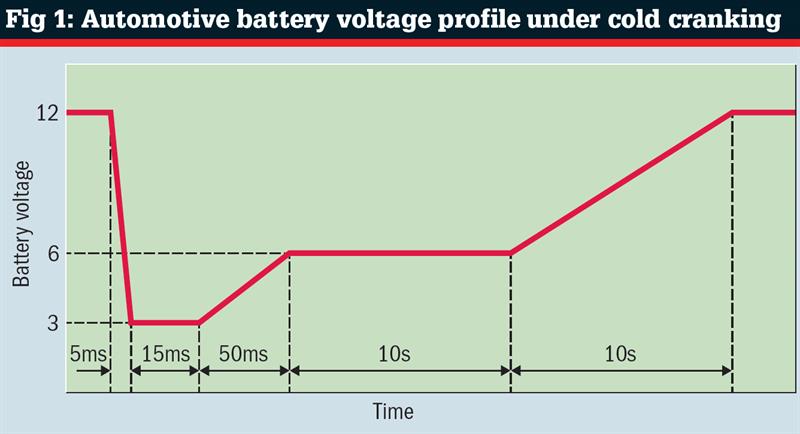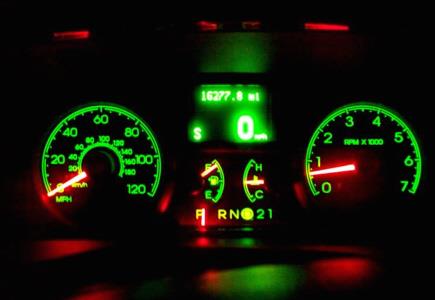Automotive manufacturers are increasingly using electronics to enhance their vehicles. The increase of the electronic content comes despite the fact that a modern vehicle is a challenging environment for silicon. In addition to the heat, vibration and grime of normal operation, drivers expect a vehicle's engine management unit and lighting to spring to life even as the vehicle's electrical power source struggles with the demands of starting an internal combustion engine – or cold cranking. That's in addition to any safety systems powered by the battery that the driver takes for granted, but must be ready to work the instant an ignition key is turned or start button is pressed.
The problem is multiplied in cold temperatures, due to factors such as increased internal battery resistance and additional cranking load from the engine's viscous lubricant. Worse yet, many modern vehicles require more frequent cold cranking than older types because their engines are automatically stopped as an economy measure every time the car comes to a halt.
The demands of cold cranking
The standard power supply in a conventional vehicle is typically a lead-acid type battery which is constructed from six 2.1V galvanic cells in series, providing a nominal 12V (actually 12.6V). In normal operation, the vehicle's battery voltage typically varies between 9 and 16V.
The variation in voltage is even greater during cold cranking. Cold cranking describes the action of starting the vehicle's engine from a temperature lower than normal operating conditions. During cold cranking, the battery is the only source of power to spin the starter motor, which in turn rotates the engine against cylinder compression, friction, and the drag of viscous lubricant. The engine needs to attain between 80 and 200rpm before it will fire.
The cold cranking ampere rating (CCA) defines the current a battery can provide at 0°F (-18°C). The rating is specified as the current that a lead-acid battery, at that temperature, can deliver for 30s while maintaining at least 1.2V per cell (7.2V for a 12V battery). Typical values for new, fully charged lead-acid batteries are in the range of 400 to 500A. The CCA of a battery varies depending on factors such a state of charge, age, and the number of recharge cycles to which it has been subjected.
No conventional automotive battery can instantly perform to its rated CCA – things take a few moments to warm up. Figure 1 illustrates a typical battery profile under cold cranking.

Within a few milliseconds, the battery voltage can drop down to around 3V and remain there for perhaps 15ms. Recovery to 6V is quite quick, but it can then take a further 20s for the voltage to rise to the nominal output.
Traditionally, the lead-acid battery powered the starting, lighting and ignition (SLI) systems of the vehicle (the device is sometimes referred to as an SLI battery). Once the engine was ticking over, the alternator supplied between 13.8 and 14.4V to power the other vehicle systems and trickle charge the battery.
Contemporary vehicles increasingly rely on the battery to provide power for items such as navigation systems, entertainment screens, and dashboards even when the engine has stopped. Vehicle occupants then expect these systems to continue operating during cold cranking – particularly in autos whose engines are stopped automatically as an economy measure during city driving and are then restarted when the driver presses the accelerator pedal.

Making the automotive grade
Semiconductors used in vehicles, particularly power chips such as DC/DC voltage converters – or regulators – must be designed to tolerate the wide voltage input variances typical of cold cranking, as well as being subject to extreme temperature ranges, vibration, and dirt. Fortunately, major silicon vendors supply a range of products targeted specifically at this market.
Many of these products comply with AEC-Q100, a set of reliability stress tests defined by the Automotive Electronics Council for the purpose of qualifying ICs for automotive applications.
Products are rated from Grade 4 to Grade 0 in four categories: mechanical stress (thermal and pressure testing); voltage bias stress; whisker growth evaluation; and power cycling.
Some manufacturers, for example Linear Technology, conduct additional device and package level stress tests. The company says it also subjects its automotive grade components to liquid to liquid thermal shock, instant solder shock and 100% oxide stress tests.
Among the components offered by Linear Technology is the LT3507, a triple channel buck voltage regulator, supplied in a 38 pad, 5 x 7mm QFN package. One channel is capable of delivering up to 2.4A, while the other two can deliver 1.5A. The company says the device's input range of 4 to 36V makes it ideal for regulating power from a wide variety of sources, including automotive batteries. In a vehicle application, the company says the LT3507's minimum input voltage of 4V enables it to operate during cold crank conditions.
Texas Instruments offers a large family of automotive grade power chips, typical of which is the LM5088. This is a non synchronous, step down ('buck') switching voltage regulator. The company says the device is qualified to AEC-Q100 Grade 1 and features an operating junction temperature ranging from –40 to 125°C.
The LM5088 features an input voltage range spanning 4.5 to 75V and can supply 8.3 to 13V. The company says the use of an emulated control ramp reduces noise sensitivity of the pulse width modulation circuit, allowing reliable control of the very small duty cycles necessary in high input voltage/low output voltage applications. The LM5088 has a switching frequency programmable from 50kHz to 1MHz. By using a bridge rectifier and high value aluminium electrolytic capacitors at the input, continuous operation is assured during the short period in the cold cranking operation when the input voltage drops to less than 4.5V.
Similarly, STMicroelectronics offers a range of AEC-Q100 qualified components in its Q Automotive series. For example, the A5973D is a switching regulator with a minimum switch current limit of 2.25A so it can deliver up to 2A DC to the load, depending on the application conditions. The output voltage can be set from 1.235 to 35V. An internal oscillator fixes the switching frequency at 250kHz. The company says that with a minimum input voltage of 4V and a maximum of 36V, the A5973D is suitable for automotive applications requiring operation even during cold cranking.
Low input voltage tolerant
The operating conditions of a modern vehicle present a challenging environment for the increasing volume of silicon. Voltage variation, especially under cold cranking, was a particularly tough problem for sensitive chips. Major switching voltage converter manufacturers have eased this problem by introducing a range of power chips which can regulate a supply within specification across a wide range of input voltages. In particular, these devices are able to continue satisfactory operation, even at the low-input voltage supplied by a lead-acid battery coping with the strain of starting a cold engine.
Author profile:
Rich Miron is with Digi-Key's technical content team.













